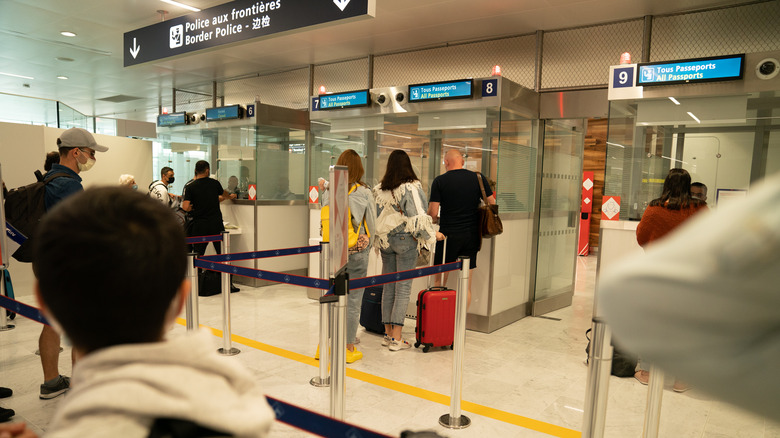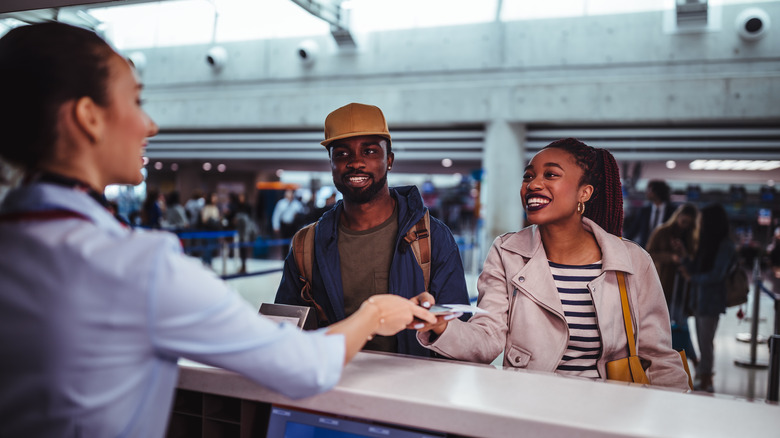Make Navigating European Airports Easier With These Genius Tips From Rick Steves
Navigating airports is notoriously stressful. Throw in a language barrier and some jet lag, and it can dull some of the shine of your vacation. Luckily, travel expert, TV host, and guidebook author Rick Steves has a few pointers about European airports courtesy of his blog Rick Steves Europe. His advice will not only help you get where you need to go, but it'll save your sanity in the process.
The first tip isn't at the airport at all. It's one you can do from the comfort of your home well before you leave. Look up the European airport you're heading to and download the terminal maps. If it's not obvious from the home page, Google the phrase "Map of Paris-Charles de Gaulle Airport." It should render as the first result, or you can scan the illustrations in the "images" tab, provided the maps are recent enough. Save a copy on your smartphone or print it out to reference when you land. If you still can't find a map, plug your search terms into YouTube to find terminal walkthroughs and advice about how to make connecting flights. The more prepared you are ahead of time, the less hectic it will be on the day you arrive.
Address the language barrier
Along with terminal maps, look up the names of the services you'll need when you arrive, like ATMs, bathrooms, luggage carousels, and airport shuttles. Though most major European airports offer signs in the local language and English, it can still be tricky, says Steves via his blog. To stick with the Paris-Charles de Gaulle Airport example, the shuttle bus that ferries passengers between terminals is called the CDGVal, which doesn't intuitively read as "airport shuttle" in English. Or at the Frankfurt airport, you might see signs that look similar, but they mean completely different things. Fernbahnhof, for example, is the station for long-distance trains. Regionalbahnhof, on the other hand, is for regional trains. It's easy to confuse the two.
A phrasebook or app like Duolingo is a great way to learn the basics, but you may have to rely on other tools to overcome the language barrier. One notable app is Scan & Translate+ Text Grabber, which can translate signs in 70-plus languages. Just hold up your phone, take a picture of the sign, and the app will translate the text. The same goes for menus and documents. Another option is to download Google Translate. You could write, "Where is the bathroom?" in the English field and watch the answer populate in French. Next, find an airport employee, press the speaker button, and the phone will ask, "Où se trouvent les toilettes?" out loud on your behalf.
Soak up amenities and ask for help
When you land, it's tempting to get away from the crowds and make a beeline for your accommodation to catch up on some rest. But now would be a good time to look around and see what amenities are available at the airport, says Steves on his blog, so it's one less thing to think about later. If there's a tourist information office, stock up on maps of the city, public transportation tickets, and packages for attractions and museums. If there's a gift shop, look for an international SIM card to pop into your smartphone. Save your data by seeing if there's free WiFi at the airport, perhaps by sitting near a fancy airport lounge.
Remember, even if you don't speak the language very well, you can always ask the airport staff for assistance. They are used to travelers, language barriers, and requests of all kinds. You can ask to make changes to your seat or what roads to take to avoid traffic en route to your hotel. If you're nervous about making a connecting flight, ask security officers if you can use the TSA PreCheck and Global Entry lanes to speed up the process. The worst they can say is no. But if they say yes, congrats, your European getaway just got a little sweeter.


